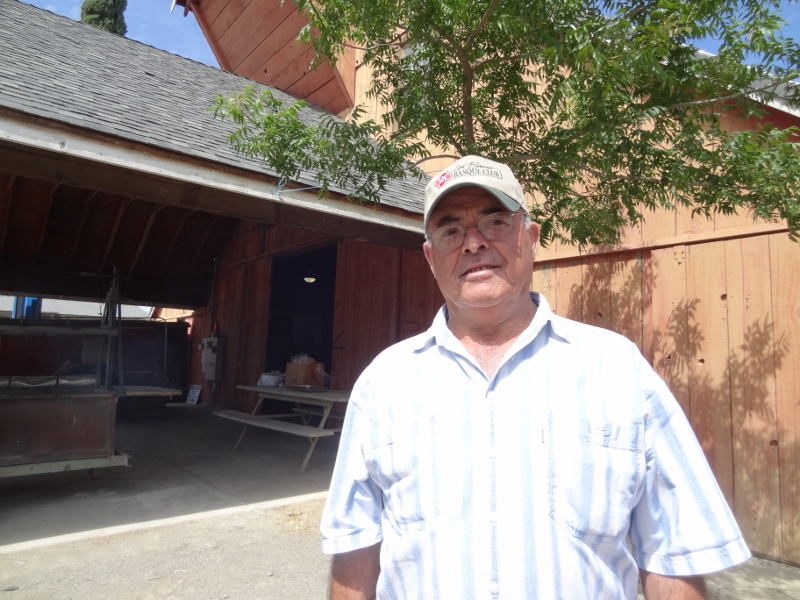basque heritage worldwide

05/22/2014

ADVERTISING
Joseba Etxarri/Los Banos, California The life of ranchers must be hard in California, judging from what Basque ranchers have to say regarding it. These are folks who are still dedicated to the profession either with dairy cattle, or cattle or sheep growers. Action taken by ecologists that push legislation that sometimes conflicts with what ranchers are trying to do, plus the extreme drought that the state has been in for the last three years, affecting agriculture, in this state that was known as the barn of the US, and even for half of the world.
-Amador, you said that it hasn’t rained for a long time here in Los Banos, California.
-Yes, it has barely rained, just drizzle, sirimiri actually is all that we’ve had lately
-And that of course affects both those engaged in agriculture, livestock and ranchers like you…
-Very much so. I know farmer ranchers who have stopped cultivating up to 40% of their land because there is no water, or the water that is accessible to them is very expensive. There are canals here and in Los Banos, we have an artificial reservoir that was constructed at the time of Kennedy, but since the ecologists have become involved, and since we ranchers fell asleep and didn’t defend ourselves, the legislation has approved tough measures that affect us significantly.
-For example?
-The water that comes to us comes from the north of the state, nearly from the border with Oregon, and at some point it mixes with sea water and is processed on its way here. So, they have found a fish that lives in the reservoir, not as big as my finger. This fish isn’t edible, but apparently it dies en route through the pumping stations and apparently legislators feel that these fish have more rights than the farmers and ranchers do who really need this water. Ecologists have a lot of power here and we weren’t staying on top of it. Who would have imagined that we would have a big empty water canal? The water goes to Los Angeles for human consumption and doesn’t reach us.
-Agriculture is the primary source of income in California.
-It is the number one industry in the state. There is also a wide variety of activities and industry but agriculture is the most important. And then there are us the ranchers. In the case of planting, almonds for example, there are some who are uprooting trees, even though its’ not easy; in addition to the extreme price of water. You have to pay the water rights and for water in the Grand Canal, you use to pay 80-90 or 100-110 dollars for acre-food. Now some are even paying up to “$2,500. If you have an alfalfa plantation or melons, you can let them die, but if you have almonds, it is an operation that lasts for 25 years in which you have invested a lot of money and that you can’t abandon just like that.
-May I ask how many head you have?
-I had about 6,000 sheep, but when the prices started to fall, I started selling them and I have been replacing them with cattle. I have over 600 Black Angus cattle, that give the best meat, but I have had to sell 200 of them, and have kept the best, to see if this drought lets up, it’s already lasted too long.
-Do you still have some sheep…
-I have always had sheep. I have fields of alfalfa and bring sheep from elsewhere, from Idaho, that come in November and go back in April.
-You came from the Basque Country in 1970 as a sheepherder. How many sheep were in Los Banos then?
-I estimate around 50,000. Today there aren’t even 7,000. It’s not profitable.
-You began working for another Basque, Bernard Erreca.
-Yes, I worked for him for six years. I thought I would return to the Basque Country but I met a very pretty girl here, the daughter of Basques from Iparralde, and I got married. Later I started my own business. 18 years after I entered the States I was able to buy the ranch I came to work in. I have 4,000 acres and supplement this with neighboring lands that I lease.
-This weekend, the Los Banos Basque Club, of which you are the president, celebrated its 50th Anniversary.
-We had been preparing for six months and were ready for Saturday and Sunday. We have received a lot of congratulations on how it all went. It was the effort of a lot of people. We are proud to be both American and Basque.
ADVERTISING
ADVERTISING
ADVERTISING
ADVERTISING
ADVERTISING
© 2014 - 2019 Basque Heritage Elkartea
Bera Bera 73
20009 Donostia / San Sebastián
Tel: (+34) 943 316170
Email: info@euskalkultura.eus